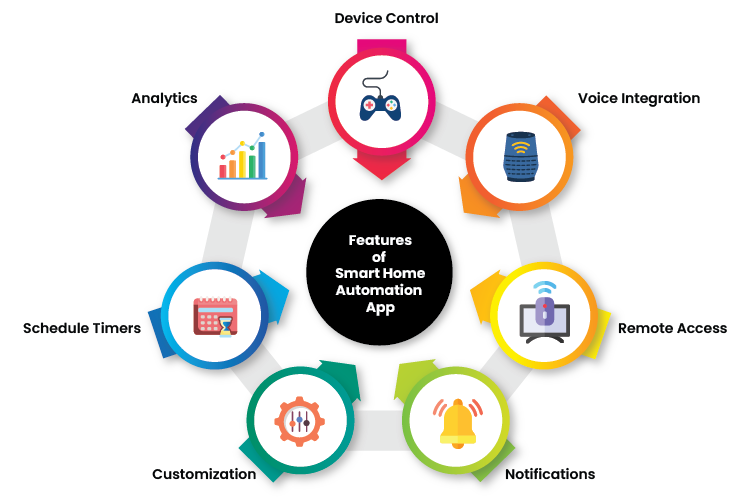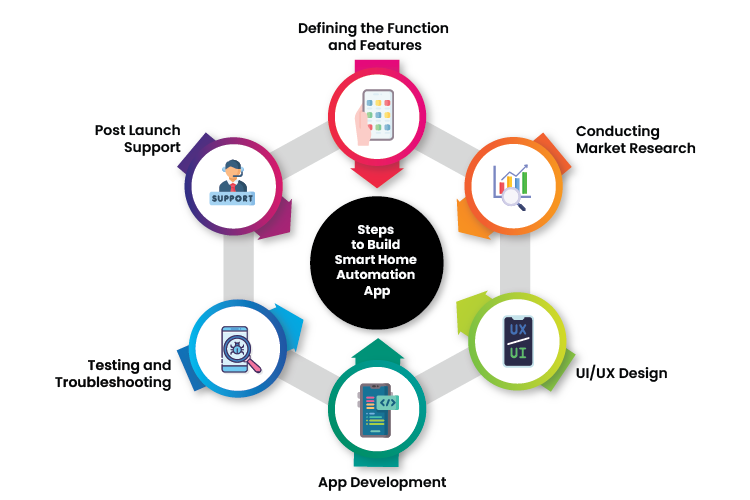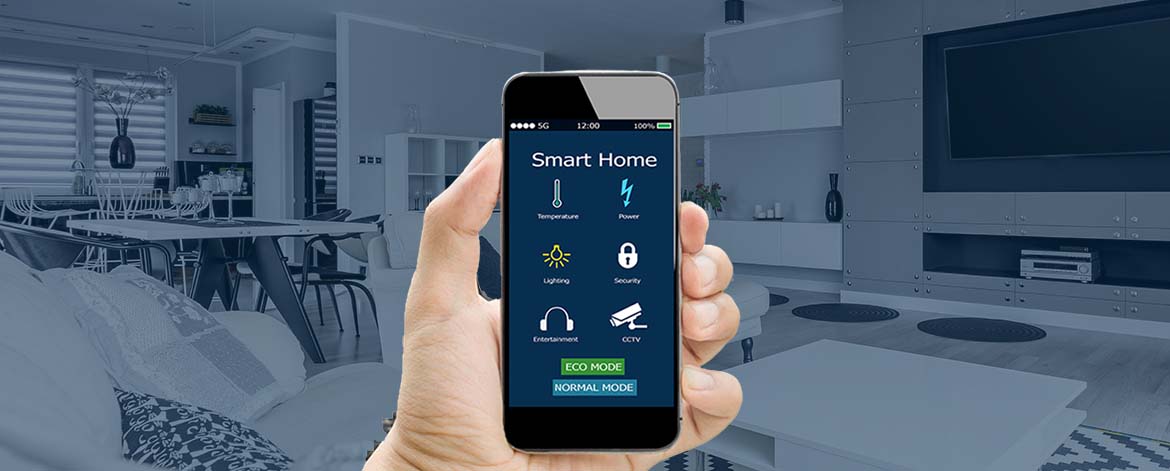Gone are the days when we used to manually change TV channels with dials and control lights and fans with switches. But nowadays, we have Smart Home automation apps that allow us to use phones to control appliances. Utilizing smart home technology allows you to control and manage various household appliances from kitchen to curtain, thereby enhancing convenience. Here it is important to have knowledge of required steps to build a smart home automation app. According to statista, Household penetration is expected to hit 21.4% by 2025. Here, this blog shades light on a complete guide on developing the best smart home app for end users and must have features in the app.
Essential Features of a Smart Home Automation App
The Home Automation app offers various features crafted to enhance the comfort, convenience, and control of your living environment. Let’s delve into some of the fundamental features that truly change these apps.
- Device Control:- Smart home automation solution relies on centralized device control, giving users a unified platform to supervise and handle all their interconnected devices.The home automation app serves as a convenient gateway to effortlessly control a range of smart devices in your home, such as lights, thermostats, door locks, and appliances. With a simple tap or voice command, you can turn these devices on or off, customize their settings, and establish schedules. This eliminates the need for navigating through multiple apps and creates a user-friendly smart home experience.
- Voice Integration:- Voice control exemplifies the hands-free, futuristic essence of smart home automation. With this feature users can manage and control their smart devices by simply giving commands. Many home automation apps easily integrate with popular voice assistants like Amazon Alexa, Google Assistant, or Apple Siri. This integration empowers users to conveniently control their smart devices using voice commands, adding extra convenience and enabling a hands-free approach.
- Remote Access:- Smart home apps allow users to control or monitor their smart devices beyond its physical location. Users have the ability to oversee and manage their devices remotely, improving both convenience and security. Whether they are at their workplace or enjoying a vacation, they can make sure their home is set up to their liking.

- Notifications:- Users get informed and can control devices with these automatic generated notifications. The device integrated with smart sensors, will send real-time alerts about unfavorable events. Whether they’re at their workplace or enjoying a vacation, they can maintain their home exactly as they desire. These notifications can cover a range of events, including shifts in temperature and lighting, alerts for smoke or water leaks and notifications for open doors or windows. It is important that users have the flexibility to personalize these notifications based on their preferences.
- Customization:- Smart home automation apps should let you create personalized scenes that control multiple devices at once. For example, with a single tap, you can dim the lights which give you a movie night vibe, close the curtains, and start your home theater system.
- Schedule Timers:- Setting timers and schedules is the foundation of automation. Users have the ability to instruct their smart devices to complete tasks at designated times or when specific conditions are met. This feature automates everyday tasks such as changing lighting or regulating temperature, making sure that the smart home easily suits their way of life.
- Analytics:- This feature allows users to review their daily habits and maybe make improvements by analyzing how they use devices, watch TV, cook, stock their fridge and when they get back from work.
Steps to Follow When Developing App for Home Automation Solution
Developing high-quality home automation apps can be a challenging task as it includes several necessary steps to be considered. This is because every home automation system functions majorly on three different levels:
- Monitoring – allows you to check device remotely with the help of app
- Control – grants device access from any place
- Automation – set up devices to activate actions automatically
Additionally, an application for smart home automation systems can be of two types: a single-task app or a multi-task app.
Regardless of the type of smart home automation app you plan to develop, here are the key areas to focus while developing apps for smart home automation . These steps include:
- Defining the Function and Features:- In the process of developing a smart home automation app, the initial step should involve defining the app’s features and capabilities. This means identifying functionalities like device management, automation rule creation and energy consumption monitoring. It is equally crucial to understand the specific needs and preferences of your target audience to ensure effective app design.
- Conducting Market Research:- Once you decide to develop an app for a home automation platform, market research should be conducted which will help to find out the features that your competitor has added in their apps. The data collected during the research phase will assist in making informed decisions about selecting the appropriate platform such as native iOS or Android or cross-platform, determining the technology stack, defining the design strategy and establishing well-defined objectives and priorities. In addition to the standard analysis of your audience, competition, market, and technology, it also takes into account the unique aspects of hardware, network, power needs, data volume and so on.

- UI/UX Design:- An attractive UI/UX can boost the engagement of users and satisfaction level. To create a good user experience, it is mandatory to think about what is the actual need of users, the latest design styles and what’s commonly done in the industry. You also need to think about where and how the device will be used. The user experience should be the same but also tailored to different devices. Ideally, using a mobile app to control a smart home device should be just as easy and fun as pressing its two physical buttons. Here , UI/UX both should match with each other.
- App Development :- Development consists of two factors: Backend and Frontend. In backend development, it is necessary to set up the databases, API for data management and communication and servers. After finalizing the design, it’s time to build the backend architecture of the app. This step is important because the app’s capacity to handle user interactions and connect with smart home systems relies on the backend system. In frontend development, the focus is on prioritizing coding in suitable programming languages and frameworks to guarantee smooth and seamless user interactions.
- Testing and Troubleshooting:- The performance of the app depends largely on the process of testing and identifying issues. Testing allows for the identification and resolution of flaws, errors, and inconsistencies within the app. In essence, a synergy between designers, developers, and stakeholders is essential for a successful and unified result.
- Post Launch Support:- The launch of an app for Home automation solutions marks the starting point. Ongoing support and maintenance are vital to ensure its continued relevance, security and competitiveness in the ever-changing tech environment. Regular updates serve not only to eliminate bugs but also to align with emerging technologies and changing user requirements.
Challenges with the Smart Home Automation App Development Process
It is a bit challenging to develop a smart home automation app as it involves many factors to consider. The following are some of the associated issues relevant to the smart home apps development process.
- Various protocols and communication standards requires integration with different devices
- Data security and privacy to make sure that user information is protected with data data encryption protocols
- Easy to navigate and user-friendly user experience
- Complexity of development as an app requires integration with hardware, API and software components
- Intense market competition requires continuous updates and innovation
- Interoperability and connectivity across diverse platforms remains a challenge for smart home apps
- Managing Performance optimization with multiple devices and data
VOLANSYS Expertise in Home Automation App Development
VOLANSYS is a leading expertise in the development of smart home automation apps. With a wealth of experience and a deep understanding of the IoT and connected home space, they excel in creating user-friendly and innovative solutions. Our expertise extends to all aspects of app development, including seamless device integration, intuitive user interfaces and robust backend systems. Whether it’s enhancing convenience, improving security, or optimizing energy efficiency, VOLANSYS delivers cutting-edge smart home automation apps that meet the diverse needs of modern homeowners.
Here are some success stories mentioned which can help you to better understand VOLANSYS capabilities in home automation:

About the Author: Krupa Jagani
As a Marketing Executive at VOLANSYS, an ACL Digital Company, Krupa combines her passion for research with competence for crafting convincing content. Her valuable expertise lies in content creation and developing impactful marketing materials.









